Study Skills Essay: Hofstede's Cultural Dimensions Analysis
VerifiedAdded on 2023/04/07
|6
|1202
|325
Essay
AI Summary
This essay analyzes the significance of Hofstede's cultural dimensions—individualism/collectivism, uncertainty avoidance, power distance, and masculinity/femininity—in the context of international business. It evaluates the importance of these dimensions, highlighting how they shape values and influence business practices across different cultures. The essay explores various suggestions for enhancing Hofstede's model, such as incorporating individual values and adapting to changes in communication. It emphasizes the impact of cultural dimensions on marketing strategies and organizational behavior. The paper supports the view that a high score on uncertainty avoidance is crucial, while disagreeing with the notion of a low score. It also suggests that organizational and individual values should be visible to all. The essay concludes that understanding these cultural dimensions is essential for success in a global business environment. It also provides suggestions for further research and analysis to better understand diverse cultures.
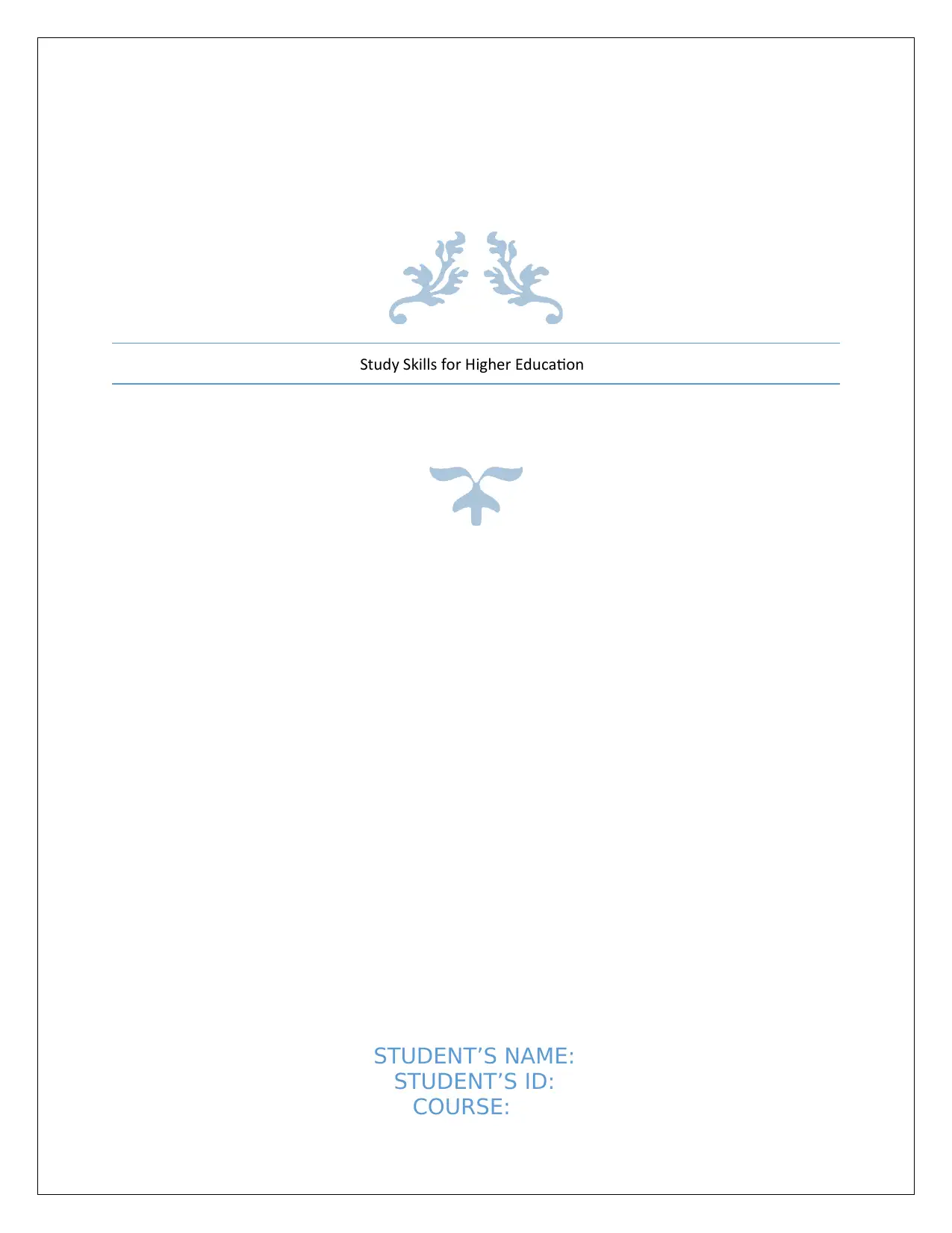
Study Skills for Higher Education
STUDENT’S NAME:
STUDENT’S ID:
COURSE:
STUDENT’S NAME:
STUDENT’S ID:
COURSE:
Paraphrase This Document
Need a fresh take? Get an instant paraphrase of this document with our AI Paraphraser
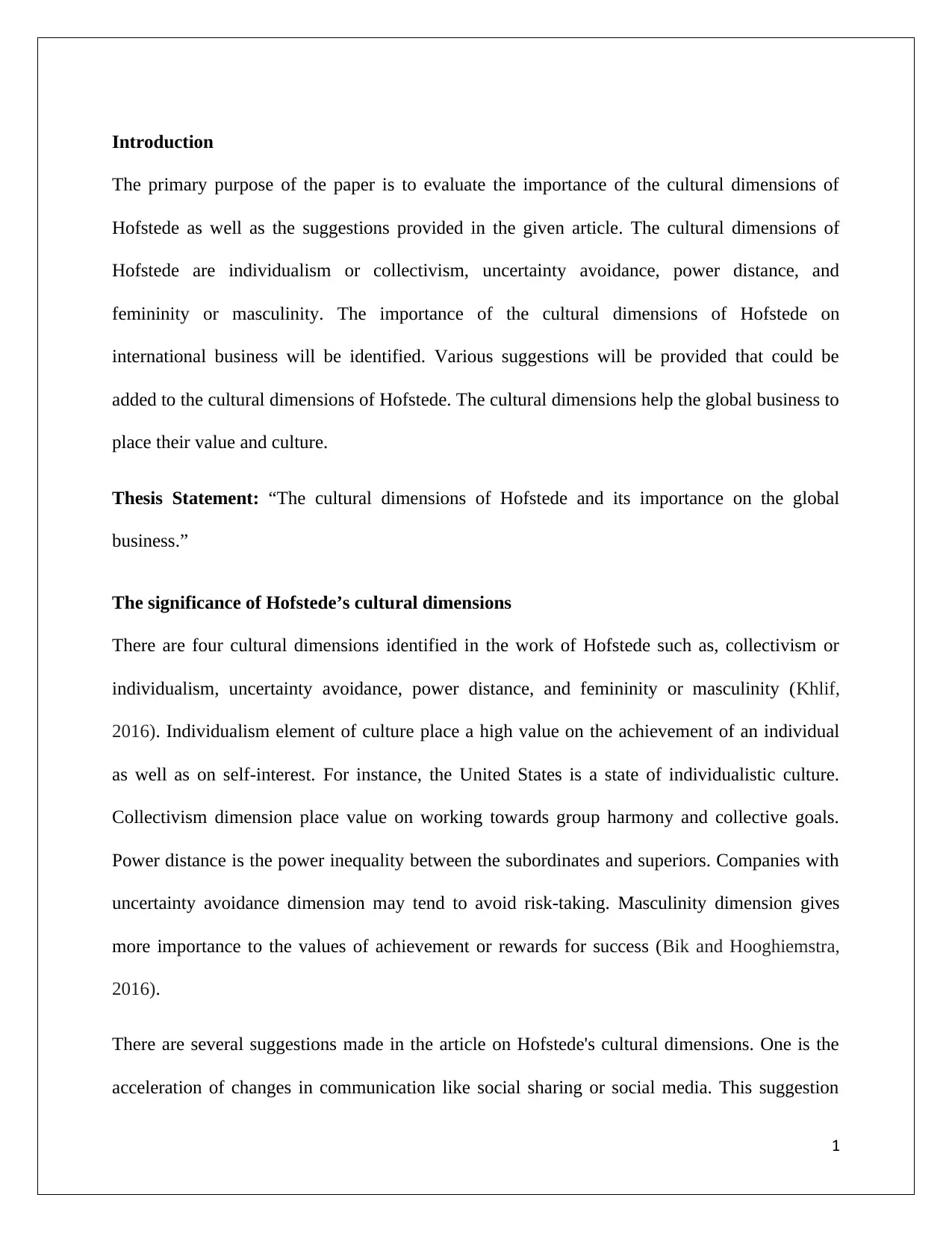
Introduction
The primary purpose of the paper is to evaluate the importance of the cultural dimensions of
Hofstede as well as the suggestions provided in the given article. The cultural dimensions of
Hofstede are individualism or collectivism, uncertainty avoidance, power distance, and
femininity or masculinity. The importance of the cultural dimensions of Hofstede on
international business will be identified. Various suggestions will be provided that could be
added to the cultural dimensions of Hofstede. The cultural dimensions help the global business to
place their value and culture.
Thesis Statement: “The cultural dimensions of Hofstede and its importance on the global
business.”
The significance of Hofstede’s cultural dimensions
There are four cultural dimensions identified in the work of Hofstede such as, collectivism or
individualism, uncertainty avoidance, power distance, and femininity or masculinity (Khlif,
2016). Individualism element of culture place a high value on the achievement of an individual
as well as on self-interest. For instance, the United States is a state of individualistic culture.
Collectivism dimension place value on working towards group harmony and collective goals.
Power distance is the power inequality between the subordinates and superiors. Companies with
uncertainty avoidance dimension may tend to avoid risk-taking. Masculinity dimension gives
more importance to the values of achievement or rewards for success (Bik and Hooghiemstra,
2016).
There are several suggestions made in the article on Hofstede's cultural dimensions. One is the
acceleration of changes in communication like social sharing or social media. This suggestion
1
The primary purpose of the paper is to evaluate the importance of the cultural dimensions of
Hofstede as well as the suggestions provided in the given article. The cultural dimensions of
Hofstede are individualism or collectivism, uncertainty avoidance, power distance, and
femininity or masculinity. The importance of the cultural dimensions of Hofstede on
international business will be identified. Various suggestions will be provided that could be
added to the cultural dimensions of Hofstede. The cultural dimensions help the global business to
place their value and culture.
Thesis Statement: “The cultural dimensions of Hofstede and its importance on the global
business.”
The significance of Hofstede’s cultural dimensions
There are four cultural dimensions identified in the work of Hofstede such as, collectivism or
individualism, uncertainty avoidance, power distance, and femininity or masculinity (Khlif,
2016). Individualism element of culture place a high value on the achievement of an individual
as well as on self-interest. For instance, the United States is a state of individualistic culture.
Collectivism dimension place value on working towards group harmony and collective goals.
Power distance is the power inequality between the subordinates and superiors. Companies with
uncertainty avoidance dimension may tend to avoid risk-taking. Masculinity dimension gives
more importance to the values of achievement or rewards for success (Bik and Hooghiemstra,
2016).
There are several suggestions made in the article on Hofstede's cultural dimensions. One is the
acceleration of changes in communication like social sharing or social media. This suggestion
1
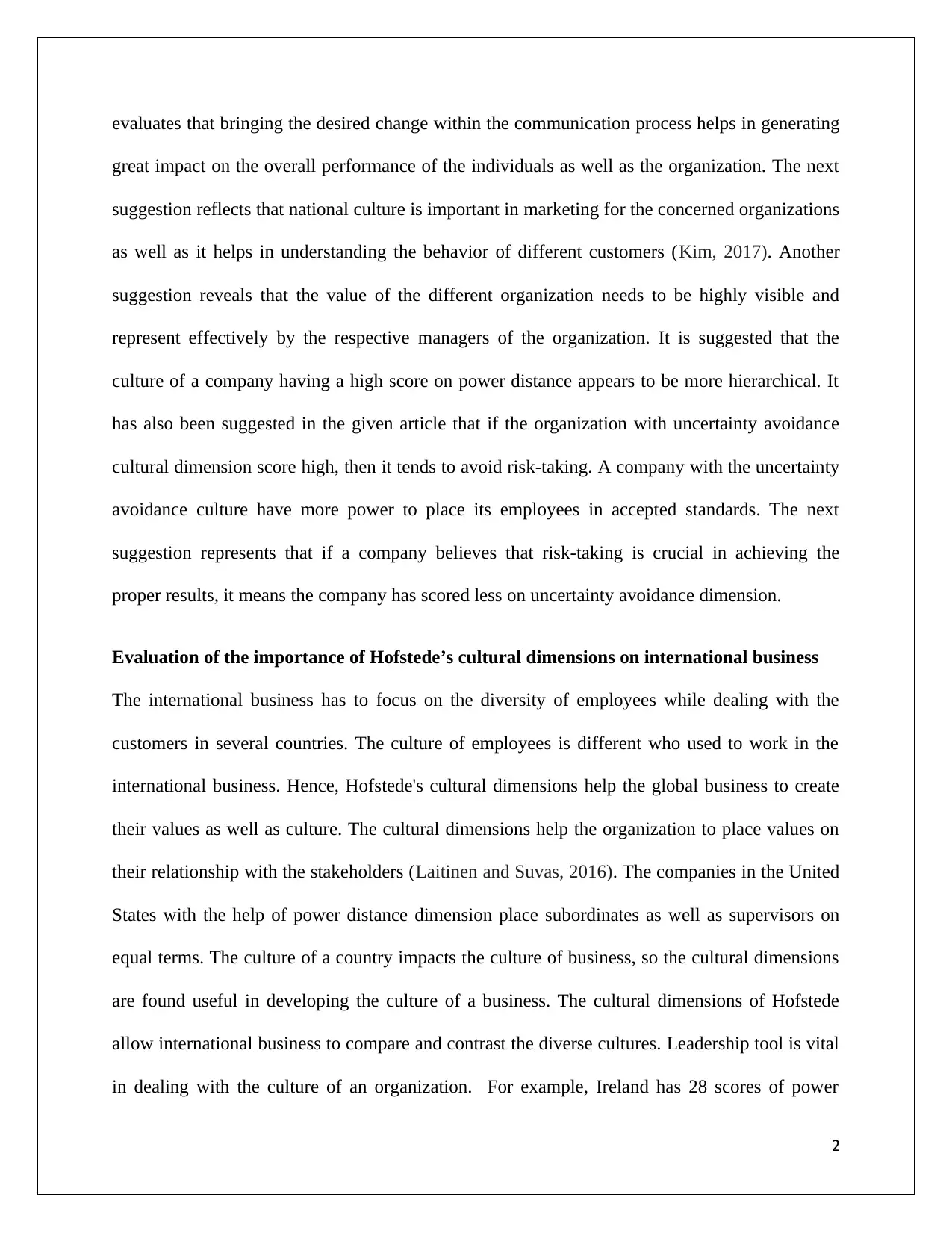
evaluates that bringing the desired change within the communication process helps in generating
great impact on the overall performance of the individuals as well as the organization. The next
suggestion reflects that national culture is important in marketing for the concerned organizations
as well as it helps in understanding the behavior of different customers (Kim, 2017). Another
suggestion reveals that the value of the different organization needs to be highly visible and
represent effectively by the respective managers of the organization. It is suggested that the
culture of a company having a high score on power distance appears to be more hierarchical. It
has also been suggested in the given article that if the organization with uncertainty avoidance
cultural dimension score high, then it tends to avoid risk-taking. A company with the uncertainty
avoidance culture have more power to place its employees in accepted standards. The next
suggestion represents that if a company believes that risk-taking is crucial in achieving the
proper results, it means the company has scored less on uncertainty avoidance dimension.
Evaluation of the importance of Hofstede’s cultural dimensions on international business
The international business has to focus on the diversity of employees while dealing with the
customers in several countries. The culture of employees is different who used to work in the
international business. Hence, Hofstede's cultural dimensions help the global business to create
their values as well as culture. The cultural dimensions help the organization to place values on
their relationship with the stakeholders (Laitinen and Suvas, 2016). The companies in the United
States with the help of power distance dimension place subordinates as well as supervisors on
equal terms. The culture of a country impacts the culture of business, so the cultural dimensions
are found useful in developing the culture of a business. The cultural dimensions of Hofstede
allow international business to compare and contrast the diverse cultures. Leadership tool is vital
in dealing with the culture of an organization. For example, Ireland has 28 scores of power
2
great impact on the overall performance of the individuals as well as the organization. The next
suggestion reflects that national culture is important in marketing for the concerned organizations
as well as it helps in understanding the behavior of different customers (Kim, 2017). Another
suggestion reveals that the value of the different organization needs to be highly visible and
represent effectively by the respective managers of the organization. It is suggested that the
culture of a company having a high score on power distance appears to be more hierarchical. It
has also been suggested in the given article that if the organization with uncertainty avoidance
cultural dimension score high, then it tends to avoid risk-taking. A company with the uncertainty
avoidance culture have more power to place its employees in accepted standards. The next
suggestion represents that if a company believes that risk-taking is crucial in achieving the
proper results, it means the company has scored less on uncertainty avoidance dimension.
Evaluation of the importance of Hofstede’s cultural dimensions on international business
The international business has to focus on the diversity of employees while dealing with the
customers in several countries. The culture of employees is different who used to work in the
international business. Hence, Hofstede's cultural dimensions help the global business to create
their values as well as culture. The cultural dimensions help the organization to place values on
their relationship with the stakeholders (Laitinen and Suvas, 2016). The companies in the United
States with the help of power distance dimension place subordinates as well as supervisors on
equal terms. The culture of a country impacts the culture of business, so the cultural dimensions
are found useful in developing the culture of a business. The cultural dimensions of Hofstede
allow international business to compare and contrast the diverse cultures. Leadership tool is vital
in dealing with the culture of an organization. For example, Ireland has 28 scores of power
2
⊘ This is a preview!⊘
Do you want full access?
Subscribe today to unlock all pages.

Trusted by 1+ million students worldwide
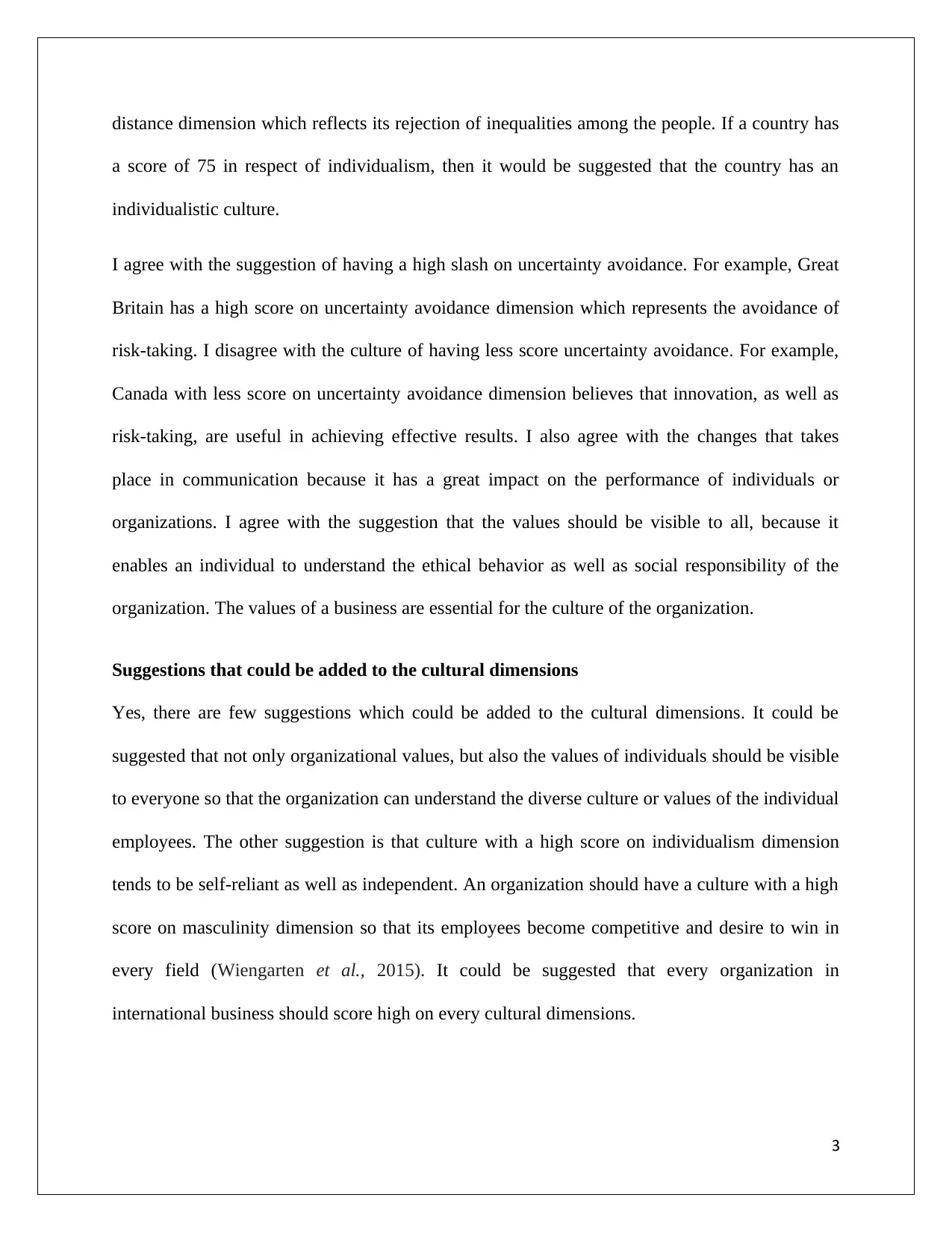
distance dimension which reflects its rejection of inequalities among the people. If a country has
a score of 75 in respect of individualism, then it would be suggested that the country has an
individualistic culture.
I agree with the suggestion of having a high slash on uncertainty avoidance. For example, Great
Britain has a high score on uncertainty avoidance dimension which represents the avoidance of
risk-taking. I disagree with the culture of having less score uncertainty avoidance. For example,
Canada with less score on uncertainty avoidance dimension believes that innovation, as well as
risk-taking, are useful in achieving effective results. I also agree with the changes that takes
place in communication because it has a great impact on the performance of individuals or
organizations. I agree with the suggestion that the values should be visible to all, because it
enables an individual to understand the ethical behavior as well as social responsibility of the
organization. The values of a business are essential for the culture of the organization.
Suggestions that could be added to the cultural dimensions
Yes, there are few suggestions which could be added to the cultural dimensions. It could be
suggested that not only organizational values, but also the values of individuals should be visible
to everyone so that the organization can understand the diverse culture or values of the individual
employees. The other suggestion is that culture with a high score on individualism dimension
tends to be self-reliant as well as independent. An organization should have a culture with a high
score on masculinity dimension so that its employees become competitive and desire to win in
every field (Wiengarten et al., 2015). It could be suggested that every organization in
international business should score high on every cultural dimensions.
3
a score of 75 in respect of individualism, then it would be suggested that the country has an
individualistic culture.
I agree with the suggestion of having a high slash on uncertainty avoidance. For example, Great
Britain has a high score on uncertainty avoidance dimension which represents the avoidance of
risk-taking. I disagree with the culture of having less score uncertainty avoidance. For example,
Canada with less score on uncertainty avoidance dimension believes that innovation, as well as
risk-taking, are useful in achieving effective results. I also agree with the changes that takes
place in communication because it has a great impact on the performance of individuals or
organizations. I agree with the suggestion that the values should be visible to all, because it
enables an individual to understand the ethical behavior as well as social responsibility of the
organization. The values of a business are essential for the culture of the organization.
Suggestions that could be added to the cultural dimensions
Yes, there are few suggestions which could be added to the cultural dimensions. It could be
suggested that not only organizational values, but also the values of individuals should be visible
to everyone so that the organization can understand the diverse culture or values of the individual
employees. The other suggestion is that culture with a high score on individualism dimension
tends to be self-reliant as well as independent. An organization should have a culture with a high
score on masculinity dimension so that its employees become competitive and desire to win in
every field (Wiengarten et al., 2015). It could be suggested that every organization in
international business should score high on every cultural dimensions.
3
Paraphrase This Document
Need a fresh take? Get an instant paraphrase of this document with our AI Paraphraser
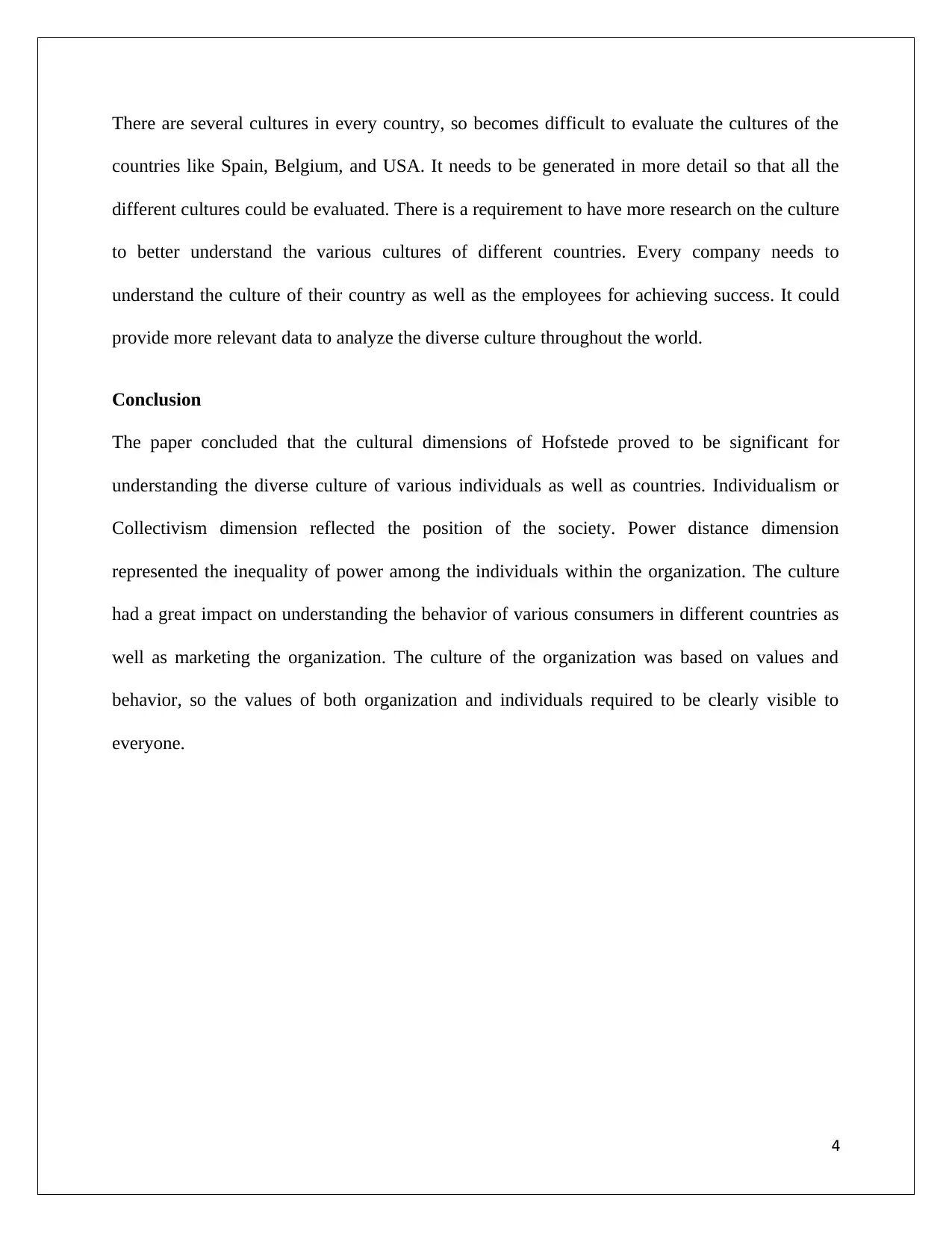
There are several cultures in every country, so becomes difficult to evaluate the cultures of the
countries like Spain, Belgium, and USA. It needs to be generated in more detail so that all the
different cultures could be evaluated. There is a requirement to have more research on the culture
to better understand the various cultures of different countries. Every company needs to
understand the culture of their country as well as the employees for achieving success. It could
provide more relevant data to analyze the diverse culture throughout the world.
Conclusion
The paper concluded that the cultural dimensions of Hofstede proved to be significant for
understanding the diverse culture of various individuals as well as countries. Individualism or
Collectivism dimension reflected the position of the society. Power distance dimension
represented the inequality of power among the individuals within the organization. The culture
had a great impact on understanding the behavior of various consumers in different countries as
well as marketing the organization. The culture of the organization was based on values and
behavior, so the values of both organization and individuals required to be clearly visible to
everyone.
4
countries like Spain, Belgium, and USA. It needs to be generated in more detail so that all the
different cultures could be evaluated. There is a requirement to have more research on the culture
to better understand the various cultures of different countries. Every company needs to
understand the culture of their country as well as the employees for achieving success. It could
provide more relevant data to analyze the diverse culture throughout the world.
Conclusion
The paper concluded that the cultural dimensions of Hofstede proved to be significant for
understanding the diverse culture of various individuals as well as countries. Individualism or
Collectivism dimension reflected the position of the society. Power distance dimension
represented the inequality of power among the individuals within the organization. The culture
had a great impact on understanding the behavior of various consumers in different countries as
well as marketing the organization. The culture of the organization was based on values and
behavior, so the values of both organization and individuals required to be clearly visible to
everyone.
4
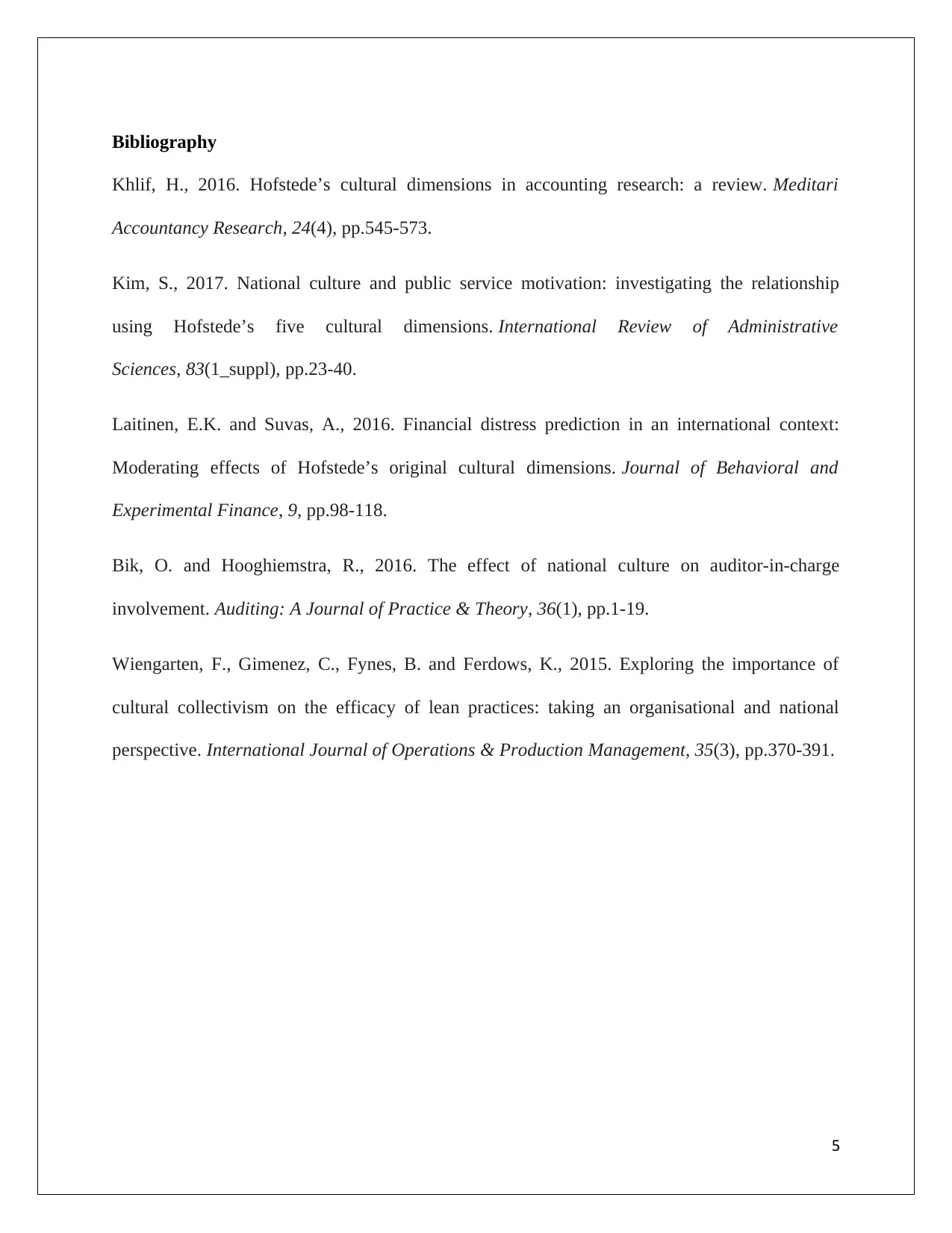
Bibliography
Khlif, H., 2016. Hofstede’s cultural dimensions in accounting research: a review. Meditari
Accountancy Research, 24(4), pp.545-573.
Kim, S., 2017. National culture and public service motivation: investigating the relationship
using Hofstede’s five cultural dimensions. International Review of Administrative
Sciences, 83(1_suppl), pp.23-40.
Laitinen, E.K. and Suvas, A., 2016. Financial distress prediction in an international context:
Moderating effects of Hofstede’s original cultural dimensions. Journal of Behavioral and
Experimental Finance, 9, pp.98-118.
Bik, O. and Hooghiemstra, R., 2016. The effect of national culture on auditor-in-charge
involvement. Auditing: A Journal of Practice & Theory, 36(1), pp.1-19.
Wiengarten, F., Gimenez, C., Fynes, B. and Ferdows, K., 2015. Exploring the importance of
cultural collectivism on the efficacy of lean practices: taking an organisational and national
perspective. International Journal of Operations & Production Management, 35(3), pp.370-391.
5
Khlif, H., 2016. Hofstede’s cultural dimensions in accounting research: a review. Meditari
Accountancy Research, 24(4), pp.545-573.
Kim, S., 2017. National culture and public service motivation: investigating the relationship
using Hofstede’s five cultural dimensions. International Review of Administrative
Sciences, 83(1_suppl), pp.23-40.
Laitinen, E.K. and Suvas, A., 2016. Financial distress prediction in an international context:
Moderating effects of Hofstede’s original cultural dimensions. Journal of Behavioral and
Experimental Finance, 9, pp.98-118.
Bik, O. and Hooghiemstra, R., 2016. The effect of national culture on auditor-in-charge
involvement. Auditing: A Journal of Practice & Theory, 36(1), pp.1-19.
Wiengarten, F., Gimenez, C., Fynes, B. and Ferdows, K., 2015. Exploring the importance of
cultural collectivism on the efficacy of lean practices: taking an organisational and national
perspective. International Journal of Operations & Production Management, 35(3), pp.370-391.
5
⊘ This is a preview!⊘
Do you want full access?
Subscribe today to unlock all pages.

Trusted by 1+ million students worldwide
1 out of 6
Related Documents
Your All-in-One AI-Powered Toolkit for Academic Success.
+13062052269
info@desklib.com
Available 24*7 on WhatsApp / Email
![[object Object]](/_next/static/media/star-bottom.7253800d.svg)
Unlock your academic potential
Copyright © 2020–2025 A2Z Services. All Rights Reserved. Developed and managed by ZUCOL.



